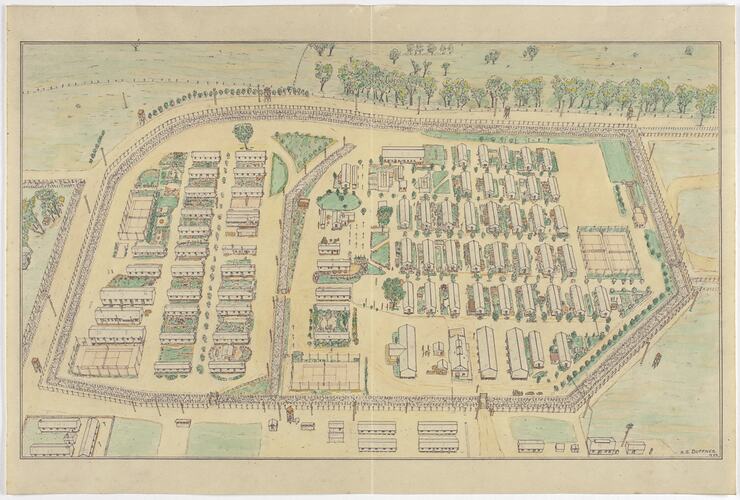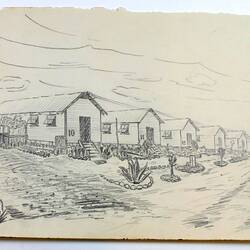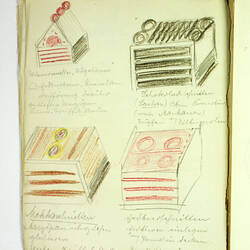Summary
This hand-drawn aerial plan illustrates Tatura Internment Camp (most likely camp 1), inscribed 'H.G. Duffner' 1944, which belonged to Karl Muffler. It documents a detailed layout of the buildings and closely reflects an aerial photograph sourced from the Aerial Survey of Victoria, Murchison 799 A2, State Library of Victoria, 1949. As such, it seems unlikely that the drawing is an artistic documentation produced onsite at the time of internment, and more likely a representation based on source materials such as the photograph after the War. The 1944 date may reflect the time Muffler and Duffner were both at Tatura, rather than the date when the drawing was executed. Hatto Guenther Herman Heinrich Duffner was released from Tatura (according to his National Archives records) in February 1946.
Karl Muffler was captured as an enemy alien in 1939 and interned as a German enemy alien at Tatura, from 1941 to 1944. He was then released to the Civil Aliens Corp Melbourne on 27th June 1944 and transferred to Broadford until his release in 1945. This is one of eight sketches completed by Karl Muffler during his internment between 1941 and 1945. H.G Duffner had studied engineering at a German university, and practised as a civil engineer from 114 Keira St Wollongong during the 1950s (he wrote several articles to the papers during this time). He lived on Corrimal Street.
This item relates to Karl Friedrich Muffler, qualified pastry chef and confectioner, born in 1900, who migrated to Melbourne from Germany in 1930, aboard the passenger liner 'Balranald'. Muffler quickly established himself in Melbourne, commencing employment with Bill Ikinger (who had recruited and sponsored him) at his cake shop in Brunswick, as well as joining the long-running German establishment 'Club Tivoli'. Muffler went on to establish his own business, 'The Embassy' in Malvern, and in 1939 married fellow German migrant Mathilde 'Hilde' Mayer. At this time they were members of the 'German Labour Front' of which Adolf Mayer (Hilde's father) was president. On 4th September, 1939 Karl Muffler, along with dozens of other German residents (including his father-in-law), was placed into police custody as an enemy alien. He was transferred to Tatura internment camp in northern Victoria and while there undertook woodcarving and drafting classes and worked as a cake decorator. He was transferred to a Forestry Commission camp in Broadford, and finally released in 1945. With no family left in Germany he decided to stay in Australia and became naturalised in 1947. He and Hilde had two daughters. After the war, Muffler accepted a position at William Angliss Food Trades School in Melbourne teaching ex-servicemen new skills in cake decoration. He also worked at Paterson's cake shop in Windsor until well into the 1970s. He maintained a connection to the German community though Club Tivoli and died in 1996.
Description of Content
A3 size printed aerial drawing, pencil and watercolour, with detailed layout of buildings.
Physical Description
A3 size printed aerial drawing, pencil and watercolour, with detailed layout of buildings.
Significance
This rich and diverse collection enables the exploration of a number of important historical themes, relating to migration as well as broader work and wartime narratives. Of key interest is the theme of working life and the proactive transporting of commercial and culinary traditions to Australia via the immigration process. Represented are the operational activities of pastry businesses around Melbourne in the 1930s, brought to life through tools and business records. The theme of internment and restriction of 'enemy aliens' during World War II can be explored through documents, mementoes, drawings, tokens and internment craft, and this collection is complemented by a large number of documents relating to Muffler held by the National Archives of Australia.The collection also provides a comprehensive overview of a migrant's experience: from garnering qualifications in country of origin to migrating; establishing a working life as practitioner and teacher; community connections and the subsequent consequences of those activities; the establishment of a domestic and social life, through marriage and ongoing cultural links; and the experiences of loss through separation through relocation, and loss of family due to war.
More Information
-
Collection Names
-
Collecting Areas
-
Acquisition Information
Donation from Ms Sue Muffler, 27 Apr 2005
-
Artist
-
Past Owner
-
Format
Drawing, Black & White
-
Inscriptions
Text: "H.G. DUFFNER / 1944".
-
Classification
-
Category
-
Discipline
-
Type of item
-
Overall Dimensions
420 mm (Width), 280 mm (Height)
-
Keywords
Cake Decorating, Forestry Camps, German Communities, German Immigration, Internment Camps, Pastry Making, World War II, 1939-1945



